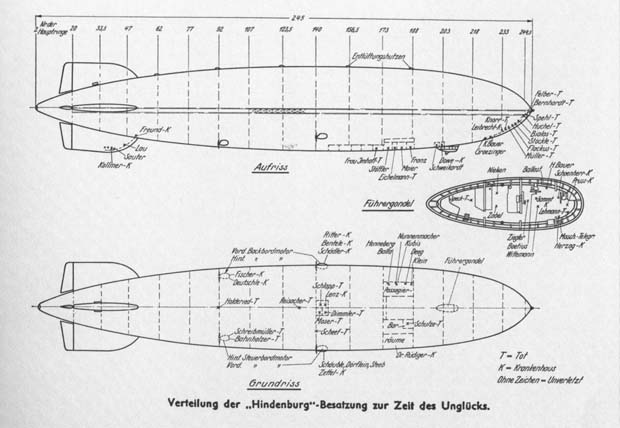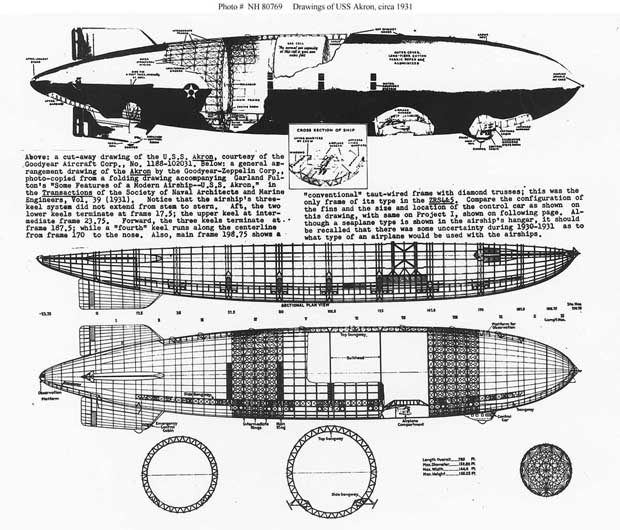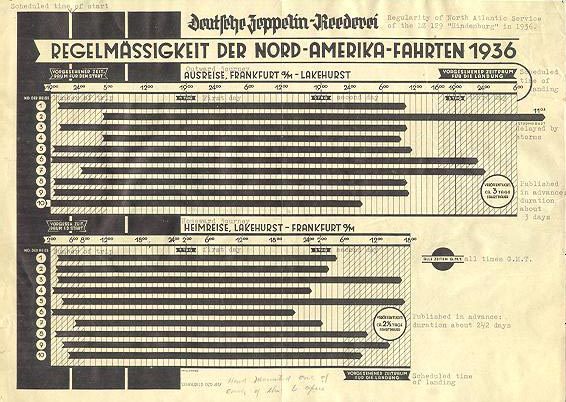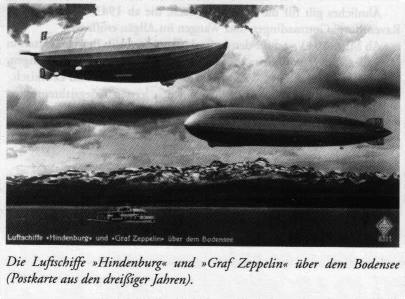 Zeppelins get their name from their creator Graf Ferdinand von Zeppelin. The rigid airships use a slim aluminum frame to shape the airbag, and to provide more strength and stability, which allowed for bigger engines and payloads. Inside the frame multiple non-pressurized gas cells are used for lift. Upon completion the frame is covered with a fabric for aerodynamic purposes. Most Zeppelins were filled with the flammable gas Hydrogen, but there were some that used the less efficient but safer helium gas, which was found only in the USA in useable quantities.
Zeppelins get their name from their creator Graf Ferdinand von Zeppelin. The rigid airships use a slim aluminum frame to shape the airbag, and to provide more strength and stability, which allowed for bigger engines and payloads. Inside the frame multiple non-pressurized gas cells are used for lift. Upon completion the frame is covered with a fabric for aerodynamic purposes. Most Zeppelins were filled with the flammable gas Hydrogen, but there were some that used the less efficient but safer helium gas, which was found only in the USA in useable quantities.
Britain attempted routes between Egypt, India & Canada but halted flights of the R100 when the more advanced R101 crashed in France on its first flight to India, killing 46 of the 54 on board. The R100 was sold for scrap in 1931.
Thanks to several accidents, America quit building airships for civilian purposes in the mid 30s, but the military continued on with their development through the war. The ZR-3 "USS Los Angeles" was the most sucessfull American Zeppelin, but was retired in 1932. In 1938 all military airships in the U.S. were placed under navy jurisdiction and used for
patrol, scouting, convoy, and antisubmarine work.

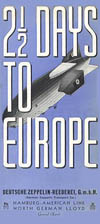 Germany in the meantime continued on with the development of their rigid airship fleet. The LZ127 Graf Zeppelin's first flight was 1928. Before the great depression started, the Graf Zeppelin had an impressive travel log, including a full circumvention of the globe, and a South American tour in May of 1930. Its because of these successes that these tours had encountered, and despite the crash of the R101, the depression and competition form fixed wing aircraft, the LZ127 increased its share of passenger & mail transportation across the ocean until 1937, when it was grounded one month after the Hindenburg disaster.
Germany in the meantime continued on with the development of their rigid airship fleet. The LZ127 Graf Zeppelin's first flight was 1928. Before the great depression started, the Graf Zeppelin had an impressive travel log, including a full circumvention of the globe, and a South American tour in May of 1930. Its because of these successes that these tours had encountered, and despite the crash of the R101, the depression and competition form fixed wing aircraft, the LZ127 increased its share of passenger & mail transportation across the ocean until 1937, when it was grounded one month after the Hindenburg disaster.
In its lifetime the Graf Zeppelin logged 590 flights for over a million miles. In 1936, the LZ129 Hindenburg joined the LZ127 Graf Zeppelin in its Trans-Atlantic flights serving the United States and Brazil.
Average flight times between Rio De Janeiro & Frankfurt was 75 hours and 60 hours between Lakehurst, New Jersey & Frankfurt. Between 1932 and 1936 the ships combined made 65 Trans-Atlantic flights. By this time they were both prominently displaying the Nazi Swastika on their fins.
Originally, because of the R100 incident, the Hindenburg was designed to use the safer helium gas instead of the volatile hydrogen, but because of the military embargo by the USA the Germans were forced to refit the Hindenburg to hydrogen instead, thus sealing its fate. At 804ft. The Hindenburg holds the record as the largest aircraft ever to fly.
Life on board
 For their $400 ticket ($720 round trip), the passengers could relax in the large, luxurious common spaces and enjoy fine food, time was spent there because the passenger cabins measured only 78 x 66 inches. Each cabin came equiped with a folding wash basin, a collapsible writing table and a signal used for calling the steward. Below you will find the description of "A Day on Board" from the Airship Hindenburg Advertising Brochure:
For their $400 ticket ($720 round trip), the passengers could relax in the large, luxurious common spaces and enjoy fine food, time was spent there because the passenger cabins measured only 78 x 66 inches. Each cabin came equiped with a folding wash basin, a collapsible writing table and a signal used for calling the steward. Below you will find the description of "A Day on Board" from the Airship Hindenburg Advertising Brochure:
 "What a wonderful night's rest you have enjoyed after your first day on board! The soft murmur from the distant engines seems to have lulled you to sleep. Now the sunshine is streaming in through the windows and you take your place in the dining saloon for a breakfast of crisp appetizing rolls and aromatic coffee.
Already, the free and east companionship of ship-board travel is in evidence. The enjoyment of airship travel makes people sociable, friendships are being formed. You finish breakfast and walk to the windows. Down below, you see the long shadow of the airship passing swiftly over the sparkling foam-crested waves of the blue Atlantic, and the joy of experiencing this wonderful achievement in modern travel surges through you. No people are confined to their cabins, for as yet no passenger has ever been sea-sick on board a Zeppelin Airship. Even in storms and squally weather, the ship's movements are quiet and steady except for the slight shock of the first onslaught.
There is no noise beyond the distant murmur of the engines and the sigh of the wind on the outer hull. No dust, no soot to trouble you, the whole atmosphere is one of tranquility and peace. The air is delicious and fresh, in fact you seem to have been transported into another and more beautiful world. For a long time you are content to watch the marvelous cloud formation or the the effect of the wind on the sea and waves beneath, and then perhaps you recline in a comfortable chair to read, join a party in a game of bridge, or chat with some new and interesting friends. Occasionally someone will call from the windows, and you will join your fellow passenger in witnessing the passing of a great liner far beneath, her rails lined with waving passengers, or the inspiring spectacle of a man-pf-war or destroyer flotilla. Mid-day arrives as if by magic, and with it the welcome sound of the dinner gong. After dinner, smokers repair to the smoking saloon. Gradually ad amidst many distractions and pleasant activities the evening advances, and the stars appear. If inclined, you take a shower bath before supper, and then a round of cocktails with some friends in the bar, followed by supper, and to end the day, a game of bridge. As you retire to your cabin it seems a miracle that already you are nearer your destination by over 1,000 miles."
"What a wonderful night's rest you have enjoyed after your first day on board! The soft murmur from the distant engines seems to have lulled you to sleep. Now the sunshine is streaming in through the windows and you take your place in the dining saloon for a breakfast of crisp appetizing rolls and aromatic coffee.
Already, the free and east companionship of ship-board travel is in evidence. The enjoyment of airship travel makes people sociable, friendships are being formed. You finish breakfast and walk to the windows. Down below, you see the long shadow of the airship passing swiftly over the sparkling foam-crested waves of the blue Atlantic, and the joy of experiencing this wonderful achievement in modern travel surges through you. No people are confined to their cabins, for as yet no passenger has ever been sea-sick on board a Zeppelin Airship. Even in storms and squally weather, the ship's movements are quiet and steady except for the slight shock of the first onslaught.
There is no noise beyond the distant murmur of the engines and the sigh of the wind on the outer hull. No dust, no soot to trouble you, the whole atmosphere is one of tranquility and peace. The air is delicious and fresh, in fact you seem to have been transported into another and more beautiful world. For a long time you are content to watch the marvelous cloud formation or the the effect of the wind on the sea and waves beneath, and then perhaps you recline in a comfortable chair to read, join a party in a game of bridge, or chat with some new and interesting friends. Occasionally someone will call from the windows, and you will join your fellow passenger in witnessing the passing of a great liner far beneath, her rails lined with waving passengers, or the inspiring spectacle of a man-pf-war or destroyer flotilla. Mid-day arrives as if by magic, and with it the welcome sound of the dinner gong. After dinner, smokers repair to the smoking saloon. Gradually ad amidst many distractions and pleasant activities the evening advances, and the stars appear. If inclined, you take a shower bath before supper, and then a round of cocktails with some friends in the bar, followed by supper, and to end the day, a game of bridge. As you retire to your cabin it seems a miracle that already you are nearer your destination by over 1,000 miles."
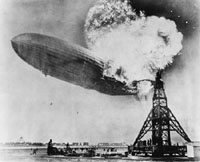 "Oh, the Humanity!"
"Oh, the Humanity!"
May 6, 1937, the Hindenburg burst into flames 200 feet over its intended landing spot at New Jersey's Lakehurst Naval Air Station. It took less than 35 seconds for the giant ship to be completely engulfed on the ground. Of the 36 passengers & 61 crew members, 35 perished in the fireball, with one death on the ground To this day there is still a question as to what caused the explosion, ranging from a lightning strike to sabotage.
At that time, reporting of events was done live, but Herbert Morrison, the reporter, did not have any equipment to broadcast live. The next morning portions of the recording were aired over WLS in Chicago, this was the first known recorded reporting of an event

 Zeppelins get their name from their creator Graf Ferdinand von Zeppelin. The rigid airships use a slim aluminum frame to shape the airbag, and to provide more strength and stability, which allowed for bigger engines and payloads. Inside the frame multiple non-pressurized gas cells are used for lift. Upon completion the frame is covered with a fabric for aerodynamic purposes. Most Zeppelins were filled with the flammable gas Hydrogen, but there were some that used the less efficient but safer helium gas, which was found only in the USA in useable quantities.
Zeppelins get their name from their creator Graf Ferdinand von Zeppelin. The rigid airships use a slim aluminum frame to shape the airbag, and to provide more strength and stability, which allowed for bigger engines and payloads. Inside the frame multiple non-pressurized gas cells are used for lift. Upon completion the frame is covered with a fabric for aerodynamic purposes. Most Zeppelins were filled with the flammable gas Hydrogen, but there were some that used the less efficient but safer helium gas, which was found only in the USA in useable quantities.

 Germany in the meantime continued on with the development of their rigid airship fleet. The LZ127 Graf Zeppelin's first flight was 1928. Before the great depression started, the Graf Zeppelin had an impressive travel log, including a full circumvention of the globe, and a South American tour in May of 1930. Its because of these successes that these tours had encountered, and despite the crash of the R101, the depression and competition form fixed wing aircraft, the LZ127 increased its share of passenger & mail transportation across the ocean until 1937, when it was grounded one month after the Hindenburg disaster.
Germany in the meantime continued on with the development of their rigid airship fleet. The LZ127 Graf Zeppelin's first flight was 1928. Before the great depression started, the Graf Zeppelin had an impressive travel log, including a full circumvention of the globe, and a South American tour in May of 1930. Its because of these successes that these tours had encountered, and despite the crash of the R101, the depression and competition form fixed wing aircraft, the LZ127 increased its share of passenger & mail transportation across the ocean until 1937, when it was grounded one month after the Hindenburg disaster.  For their $400 ticket ($720 round trip), the passengers could relax in the large, luxurious common spaces and enjoy fine food, time was spent there because the passenger cabins measured only 78 x 66 inches. Each cabin came equiped with a folding wash basin, a collapsible writing table and a signal used for calling the steward. Below you will find the description of "A Day on Board" from the Airship Hindenburg Advertising Brochure:
For their $400 ticket ($720 round trip), the passengers could relax in the large, luxurious common spaces and enjoy fine food, time was spent there because the passenger cabins measured only 78 x 66 inches. Each cabin came equiped with a folding wash basin, a collapsible writing table and a signal used for calling the steward. Below you will find the description of "A Day on Board" from the Airship Hindenburg Advertising Brochure: "What a wonderful night's rest you have enjoyed after your first day on board! The soft murmur from the distant engines seems to have lulled you to sleep. Now the sunshine is streaming in through the windows and you take your place in the dining saloon for a breakfast of crisp appetizing rolls and aromatic coffee.
Already, the free and east companionship of ship-board travel is in evidence. The enjoyment of airship travel makes people sociable, friendships are being formed. You finish breakfast and walk to the windows. Down below, you see the long shadow of the airship passing swiftly over the sparkling foam-crested waves of the blue Atlantic, and the joy of experiencing this wonderful achievement in modern travel surges through you. No people are confined to their cabins, for as yet no passenger has ever been sea-sick on board a Zeppelin Airship. Even in storms and squally weather, the ship's movements are quiet and steady except for the slight shock of the first onslaught.
There is no noise beyond the distant murmur of the engines and the sigh of the wind on the outer hull. No dust, no soot to trouble you, the whole atmosphere is one of tranquility and peace. The air is delicious and fresh, in fact you seem to have been transported into another and more beautiful world. For a long time you are content to watch the marvelous cloud formation or the the effect of the wind on the sea and waves beneath, and then perhaps you recline in a comfortable chair to read, join a party in a game of bridge, or chat with some new and interesting friends. Occasionally someone will call from the windows, and you will join your fellow passenger in witnessing the passing of a great liner far beneath, her rails lined with waving passengers, or the inspiring spectacle of a man-pf-war or destroyer flotilla. Mid-day arrives as if by magic, and with it the welcome sound of the dinner gong. After dinner, smokers repair to the smoking saloon. Gradually ad amidst many distractions and pleasant activities the evening advances, and the stars appear. If inclined, you take a shower bath before supper, and then a round of cocktails with some friends in the bar, followed by supper, and to end the day, a game of bridge. As you retire to your cabin it seems a miracle that already you are nearer your destination by over 1,000 miles."
"What a wonderful night's rest you have enjoyed after your first day on board! The soft murmur from the distant engines seems to have lulled you to sleep. Now the sunshine is streaming in through the windows and you take your place in the dining saloon for a breakfast of crisp appetizing rolls and aromatic coffee.
Already, the free and east companionship of ship-board travel is in evidence. The enjoyment of airship travel makes people sociable, friendships are being formed. You finish breakfast and walk to the windows. Down below, you see the long shadow of the airship passing swiftly over the sparkling foam-crested waves of the blue Atlantic, and the joy of experiencing this wonderful achievement in modern travel surges through you. No people are confined to their cabins, for as yet no passenger has ever been sea-sick on board a Zeppelin Airship. Even in storms and squally weather, the ship's movements are quiet and steady except for the slight shock of the first onslaught.
There is no noise beyond the distant murmur of the engines and the sigh of the wind on the outer hull. No dust, no soot to trouble you, the whole atmosphere is one of tranquility and peace. The air is delicious and fresh, in fact you seem to have been transported into another and more beautiful world. For a long time you are content to watch the marvelous cloud formation or the the effect of the wind on the sea and waves beneath, and then perhaps you recline in a comfortable chair to read, join a party in a game of bridge, or chat with some new and interesting friends. Occasionally someone will call from the windows, and you will join your fellow passenger in witnessing the passing of a great liner far beneath, her rails lined with waving passengers, or the inspiring spectacle of a man-pf-war or destroyer flotilla. Mid-day arrives as if by magic, and with it the welcome sound of the dinner gong. After dinner, smokers repair to the smoking saloon. Gradually ad amidst many distractions and pleasant activities the evening advances, and the stars appear. If inclined, you take a shower bath before supper, and then a round of cocktails with some friends in the bar, followed by supper, and to end the day, a game of bridge. As you retire to your cabin it seems a miracle that already you are nearer your destination by over 1,000 miles."
 "Oh, the Humanity!"
"Oh, the Humanity!"